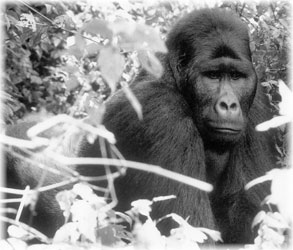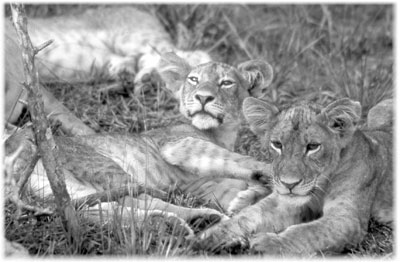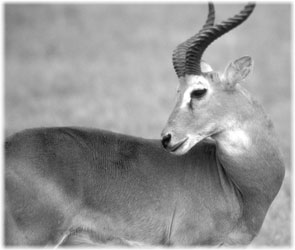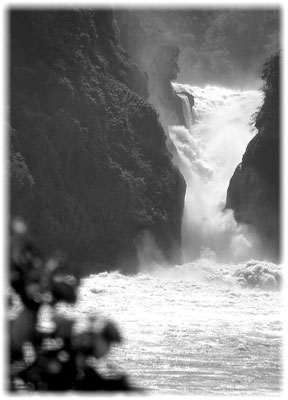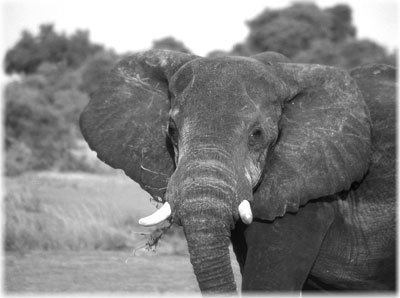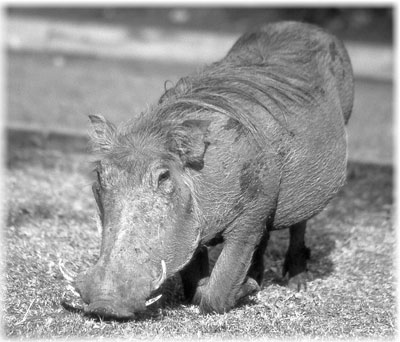Uganda — habitat for diverse wildlife
—John Chatfield, Contributing Editor
As Dickens once wrote, “It was the best of times, it was the worst of times....” So it was on my July ’05 African wildlife adventure to Uganda.
The worst was trying to find the mountain gorillas in the Mgahinga Gorilla National Park. The best, finally finding a family of 18, shyly hiding in the thick underbrush. Unfortunately, we were never able to get a clear look at these fantastic animals.
Uganda is not only known for gorillas, as we had earlier seen the vast offering of wildlife of this beautiful country in the Bwindi Impenetrable National Park (it is aptly named).
The wild side
The brochures tell you that to go gorilla tracking, you must be in reasonably good shape. I would caution that you should be in very good shape. Mgahinga starts at 2,227 meters in elevation and rises to 4,127 meters.
Our group of five started trekking at 9:10 a.m., traveling up and down some very steep terrain. We finally located the gorillas at 1:30 p.m. The gorillas were on the side of a mountain with a 60-degree slope, and they stayed hidden except for occasional glimpses during our one-hour visit.
Only six people are allowed to trek into the park each day, and the stay once you have spotted the gorillas is for no more than an hour. Many times the gorillas are in a clear area where great photographs can be taken, but we were unlucky.
After our visit with the gorillas, we started back and had been traveling for perhaps a half hour when one member of our group was unable to continue. Each of us had hired porters to carry our water, etc., and they built a litter and carried the man out.
Shortly thereafter the sky opened up and it poured down rain for 2½ hours. It also thundered and there were some very close bolts of lightning. We were soaked to the skin, and the narrow dirt paths turned to mud and were very slippery.
The small streams we had crossed coming in were now knee deep and quite swift. We were slipping and sliding and falling down for about four hours.
I didn’t realize how close I was to getting out — only about 300 meters — when, absolutely exhausted, I asked the porters to carry me the rest of the way. As the last two members of our group staggered to the vehicles, it was 7:40 p.m. — the park had closed at 7:30.
I paid my porter with soaking wet money and watched him lighting matches to try to dry it out.
Would I discourage you from embarking on this once-in-a-lifetime experience? Absolutely not!
The mild side
The rest of our safari in Uganda was quite mild.
By African standards, Uganda is quite small. Situated at the heart of the continent and sandwiched between Kenya, Rwanda, the Democratic Republic of the Congo, Sudan and Tanzania, it is roughly the size of Great Britain or the state of Oregon.
Uganda is a beautiful country with forests, lakes and mountains, and, although it lies on the equator, the climate is tempered by its altitude.
We started our adventure in Kampala, the capital of Uganda, and flew by charter aircraft to Murchison Falls National Park for our stay of two nights at Paraa Safari Lodge.
Paraa is perched atop a gorge that towers above the Nile River, which starts its long journey to the Mediterranean Sea from Lake Victoria, the largest lake in Africa, and traverses the park. The accommodations were very nice and the food, excellent.
The lodge’s airstrip is only an hour’s flight from Entebbe Airport. To drive would take over five hours, and I am sure the roads aren’t good.
Murchison Falls National Park, with its palm-studded grasslands, supports large populations of lions, buffalo, elephants, Rothschild’s giraffes, oribi, leopards and the Uganda kob, an antelope indigenous only to Uganda. On one game drive we also spotted Jackson’s hartebeests and numerous Defassa waterbucks.
Although we went on several safari drives and viewed many of the species located in the park, the highlight was a boat trip on the Nile to the base of Murchison Falls. The fall plunges 43 meters (141 feet) from the precipice to a pool below in a thunder of noise and spray. The mighty Nile flows through a modest 6-meter-wide cleft, which makes it wild and noisy.
The boat trip allows you to view animals along the shore and provides a chance to spot some of the more than 450 bird species that reside in the park. We also saw crocodiles as well as large groupings of hippos.
About 1½ miles from the bottom of the fall, the more intrepid of our group disembarked and proceeded to climb to the top, where the view was quite stunning. Those less inclined to make the climb can also reach the top by road.
In 1962, after some very heavy rains, a second fall was formed called Uhuru, or Freedom, Falls.
After years of decimation during the Idi Amin tenure, the wildlife population is now increasing nicely. Murchison Falls has just imported white rhinos from Kenya, and the park is starting a breeding program and will eventually release the rhinos back into the wild.
Queen Elizabeth National Park
After another short flight on our charter Eagle Air plane, we arrived at Queen Elizabeth National Park, landing on the airstrip right next to Mweya Safari Lodge, located on a peninsula overlooking Lake George. The lodge’s recent renovation was extremely well done.
The area around the lodge has a vast wetland system comprising two main lakes, George and Edward, in addition to the connecting Kazinga Channel. Thousands of hippos populate these lake shorelines, and open savannah dotted with acacia and euphorbia trees provide habitat for elephants, lions, leopards, Uganda kob and large herds of Cape buffalo.
The park is also home to primate species, including chimpanzees, as well as giant forest hogs, waterbucks, topi, hyenas and crocodiles, not to mention 604 bird species, more than in any other park in Africa.
In addition to taking two game drives, we visited Kyambura Gorge, home to chimpanzees, black and white colobus and red-tailed monkeys, olive baboons and other primates. However, the guided nature walk there takes several hours and we simply didn’t have enough time.
Our final adventure in Queen Elizabeth National Park was a boat ride up and back the Kazinga Channel. We were eye to eye with yawning hippos, and the banks were crowded with vast numbers of migrant and resident waterbirds. Crocs and buffalo rested on the river’s edge, and elephants came down to the water. We even spotted a pair of lions that had come down for a drink.
Winding down
As our safari actually ended in Kisoro, the small town near the gorilla park, we were soon on our charter flight back to Entebbe International Airport. I won’t soon forget this memorable trip as I look at the gorilla tracking certificate that I received after completing the trek.
This trip was sponsored by the Uganda Tourist Board (13/15 Kimathi Ave., Impala House, P.O. Box 7211, Kampala, Uganda; www.visituganda.com) in conjunction with African Travel, Inc.
Our flight from New York was on Emirates. After an overnight in Dubai, it was on to Entebbe. We flew coach, and the service and food were very good.
African Travel can arrange a duplicate of our 9-day safari for $2,790 per person, sharing rooms.
African Travel also has an 8-day safari beginning in Kampala and including visits to Queen Elizabeth National Park; Kyambura Gorge, to track chimpanzees; the Kibale Forest, with 13 species of primates, and the Bwindi Impenetrable Forest (via Ishasha, home of the tree-climbing lions), ending in Kampala for your return home. This safari is priced at $2,450 per person, sharing. Private departures and custom itineraries to Uganda are also available.
For more information, contact African Travel, Inc. (1100 East Broadway, Glendale, CA 91205; phone 800/421-8907 or visit www.africantravelinc.com).

